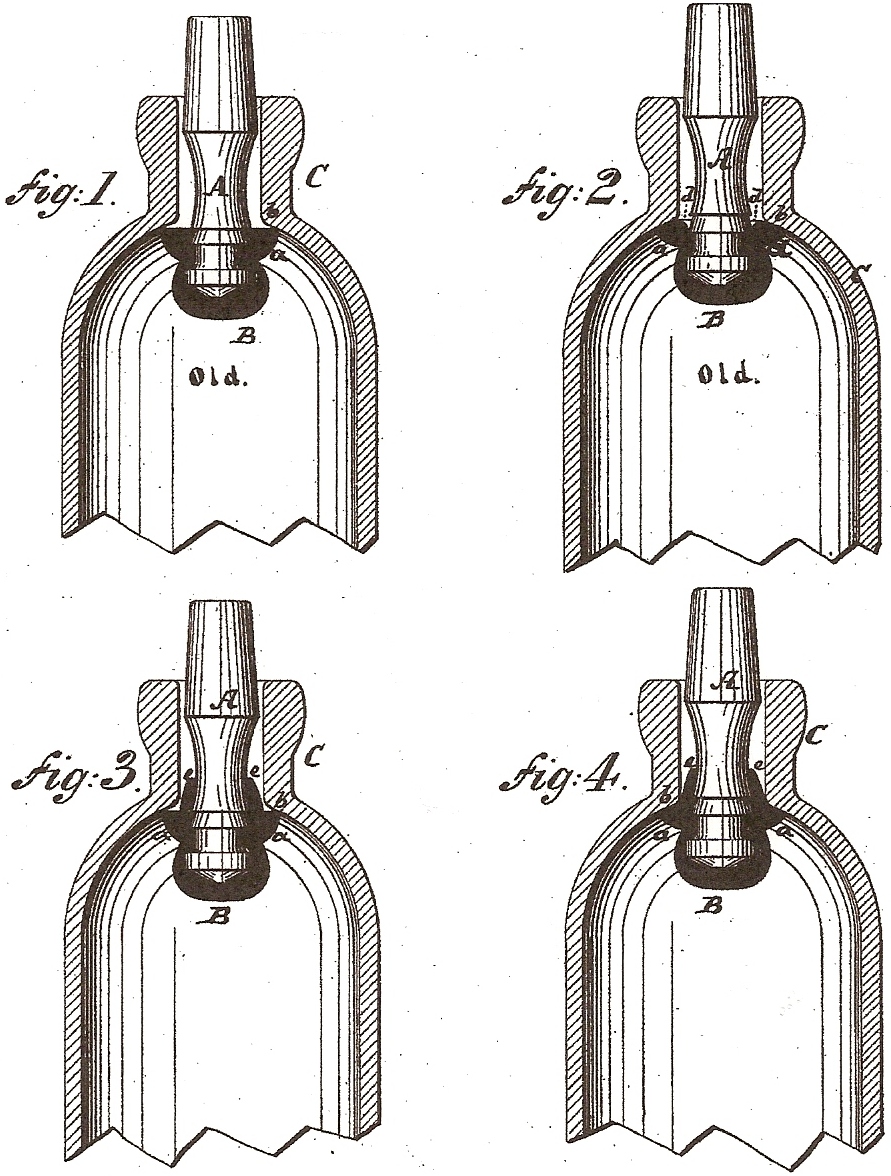Joseph Conner Bottle Stopper

Joseph Conner’s patent
application was filed March 13, 1886, and assigned to The Firm of John
Matthews. This patent
specified:
I, Joseph Conner, of…
Figure 1 and 2 represent sectional side views of
bottle-stoppers of well-known construction, to which my invention is
intended to be applied.
Figs. 3 and 4 represent similar views of my improved stoppers.
The object of this invention is to provide certain
internal bottle-stoppers…which are intended to close upwardly with an
elastic peripheral flange against the seat in the throat of the bottle –
with a packing which shall at all times hug the stem of the stopper.
The old kind of stoppers, which I seek to improve, is
represented in Figs. 1 and 2 of the drawings, and consists of a rigid
stem, A, and a rubber or
other flexible packing, B,
which packing is slipped upon the lower end of the stem, so as to
tightly embrace and surround the same.
The packing B has an
outwardly-projecting flexible flange,
a, which seats against the
throat b of the bottle
C.
The difficulty with this kind of stopper is that when pressure is
applied internally against the stopper the flange
a will be distended or
crowded outward, as is clearly shown in Fig. 2, so as to partly draw the
upper portion of the packing away from the stem
A and produce an annular
cavity, d, around said stem.
This cavity will remain open to the reception of dust, insects,
and other impurities during the entire period of time the bottle is
charged with gaseous liquid, and when afterward the bottle is emptied
the packing B will again
close on the stem and grasp and retain the impurities which settle in
said cavity or groove d.
As these stoppers, when the bottle is being opened,
are forced into the liquid contents thereof, the aforesaid impurities
will become in part absorbed by the liquid, tainting the same.
This is one of the principal difficulties connected with the use
of ordinary bottle-stoppers.
They serve to taint the liquid by the above-mentioned impurities
and at all times to retain sufficient of the impurities to be
objectionable in continual use.
The stoppers, being within the bottle, cannot conveniently be
cleaned, especially if the impurities settle, as has been stated, in a
cavity, which becomes subsequently closed whenever the bottle is opened.
My invention consists in providing a packing of the
kind stated, and which surrounds the lower part of the stem and carries
the flange a, with an upward
projection, e, on the packing
directly above the seat or flange portion
a, so that said
upwardly-projecting tubular portion
e of the packing will at all
times tightly hug the stem A.
When pressure is applied to the stopper from within and the
seat or flange portion a
distended, as in Fig. 4, the tubular projection
e will thereby be drawn down
on the stem, still tightly hugging the same, all as shown in Fig. 4.
By this means the objectionable open groove or cavity heretofore
referred to is avoided, and all danger of contaminating the liquid with
impurities that settle in the folds of the stopper obviated.
Comments:
This patent was included in this review to highlight
the industry’s continuing struggle to prevent the contamination of
bottle contents. See
Matthews Patents No. 67,781 and 137,941 for additional comments about
Matthews Gravitating Stopper bottles,
Hutchinson Bottle Directory
cataloguing guidelines, and previous design improvements.
Soon after John Conner’s patent was granted, The Firm of John Matthews
began to advertise these latest improvements.
The following advertisement ran in the March 1, 1887 issue of
National Bottlers’ Gazette
(a special THANK YOU to David Graci, author of
Soda and Beer BOTTLE
CLOSURES 1850 – 1910 for providing this great illustration).
Although this advertisement mentioned the improved stoppers were
“the best substitute ever offered for corks, and obviate all former
objections to the use of patent stoppers,” the “POINTS OF SUPERIORITY
OVER ALL OTHERS STOPPERS” were clearly aimed at slowing down the rapidly
increasing conversion to the use of

 HutchBook.com
HutchBook.com